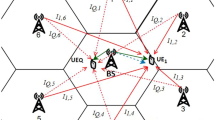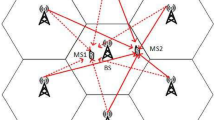Abstract
Non-orthogonal multiple access (NOMA) is very promising for the future wireless communication systems. The primary goal of this paper is to provide precise outage probability formulas for downlink-NOMA-based communication systems over non-homogeneous fading scenarios. The outage probability of NOMA is analyzed over \(\kappa -\mu , \alpha -\kappa -\mu\) faded and shadowed faded channels. Other fading channels result as special cases of this analysis. The closed-form expressions of outage probability are derived in a more realistic scenario considering the imperfect-channel state information (CSI) and successive interference cancellation, intra and inter-cellular interference. The derived expressions are very beneficial to asses the performance of NOMA with different fading parameters. We calculate the outage probability for two users in a Voronoi cell: near user and edge user. The obtained results are very promising, when compared with the simulated NOMA based wireless communication system. It is observed that the impact of imperfect-CSI on both users is the same. The effect of inter-cell interference is not a serious concern for the MSs which lie at the proximity of the BS. However, the performance of the MS which lies at the edge of the cell is degraded with the number of interferers.















Similar content being viewed by others
Data availability
All the data and materials are available with us for this research paper.
Code availability
The results are done with the help of MATLAB and corresponding files are available with us. Based on the request we will share the relevant source codes.
References
Ding, Z., Yang, Z., Fan, P., & Poor, H. V. (2014). On the performance of non-orthogonal multiple access in 5g systems with randomly deployed users. IEEE Signal Processing Letters, 21(12), 1501–1505.
Benjebbovu, A., Li, A., Saito, Y., Kishiyama, Y., Harada, A., & Nakamura, T. (2013). System-level performance of downlink noma for future LTE enhancements. In 2013 IEEE Globecom Workshops (GC Wkshps), pp. 66–70, IEEE.
Wang, Y., Ren, B., Sun, S., Kang, S., & Yue, X. (2016). Analysis of non-orthogonal multiple access for 5g. China Communications, 13(2), 52–66.
Islam, S. R., Avazov, N., Dobre, O. A., & Kwak, K.-S. (2016). Power-domain non-orthogonal multiple access (NOMA) in 5g systems: Potentials and challenges. IEEE Communications Surveys & Tutorials, 19(2), 721–742.
Ding, Z., Lei, X., Karagiannidis, G. K., Schober, R., Yuan, J., & Bhargava, V. K. (2017). A survey on non-orthogonal multiple access for 5g networks: Research challenges and future trends. IEEE Journal on Selected Areas in Communications, 35(10), 2181–2195.
Kimy, B., Lim, S., Kim, H., Suh, S., Kwun, J., Choi, S., Lee, C., Lee, S., & Hong, D. (2013). Non-orthogonal multiple access in a downlink multiuser beamforming system. In MILCOM 2013-2013 IEEE Military Communications Conference, pp. 1278–1283, IEEE.
Marshoud, H., Kapinas, V. M., Karagiannidis, G. K., & Muhaidat, S. (2015). Non-orthogonal multiple access for visible light communications. IEEE Photonics Technology Letters, 28(1), 51–54.
Hou, T., Sun, X., & Song, Z. (2018). Outage performance for non-orthogonal multiple access with fixed power allocation over Nakagami-m fading channels. IEEE Communications Letters, 22(4), 744–747.
Ahmed, M. A., Baz, A., & Tsimenidis, C. C. (2020). Performance analysis of NOMA systems over Rayleigh fading channels with successive-interference cancellation. IET Communications, 14(6), 1065–1072.
Wang, J., Xia, B., Xiao, K., Gao, Y., & Ma, S. (2018). Outage performance analysis for wireless non-orthogonal multiple access systems. IEEE Access, 6, 3611–3618.
Wang, X., Wang, J., He, L., & Song, J. (2017). Outage analysis for downlink NOMA with statistical channel state information. IEEE Wireless Communications Letters, 7(2), 142–145.
Yang, Z., Ding, Z., Fan, P., & Karagiannidis, G. K. (2015). On the performance of non-orthogonal multiple access systems with partial channel information. IEEE Transactions on Communications, 64(2), 654–667.
Ding, Z., Yang, Z., Fan, P., & Poor, H. V. (2014). On the performance of non-orthogonal multiple access in 5g systems with randomly deployed users. IEEE Signal Processing Letters, 21(12), 1501–1505.
Zhang, Z., Sun, H., & Hu, R. Q. (2017). Downlink and uplink non-orthogonal multiple access in a dense wireless network. IEEE Journal on Selected Areas in Communications, 35(12), 2771–2784.
Men, J., & Ge, J. (2015). Performance analysis of non-orthogonal multiple access in downlink cooperative network. IET Communications, 9(18), 2267–2273.
Men, J., Ge, J., & Zhang, C. (2016). Performance analysis of nonorthogonal multiple access for relaying networks over Nakagami-\(m\) fading channels. IEEE Transactions on Vehicular Technology, 66(2), 1200–1208.
Han, A., Lv, T., & Zhang, X. (2019). Outage performance of noma-based uav-assisted communication with imperfect sic. In 2019 IEEE Wireless Communications and Networking Conference (WCNC), pp. 1–6, IEEE.
Usman, M. R, Khan, A., Usman, M. A., Jang, Y. S., & Shin, S. Y. (2016). On the performance of perfect and imperfect sic in downlink non orthogonal multiple access (noma). In 2016 International Conference on Smart Green Technology in Electrical and Information Systems (ICSGTEIS), pp. 102–106, IEEE.
Li, S, Derakhshani, M., & Lambotharan, S. (2018). Outage-constrained robust power allocation for downlink mc-noma with imperfect sic. In 2018 IEEE International Conference on Communications (ICC), pp. 1–7, IEEE.
Zhao, J., Yue, X., Kang, S., & Tang, W. (2021). Joint effects of imperfect CSI and sic on NOMA based satellite-terrestrial systems. IEEE Access, 9, 12545–12554.
Do, D.-T., & Nguyen, T.-T.T. (2019). Impacts of imperfect sic and imperfect hardware in performance analysis on AF non-orthogonal multiple access network. Telecommunication Systems, 72(4), 579–593.
Arzykulov, S., Nauryzbayev, G., Celik, A., & Eltawil, A. M. (2021). Hardware and interference limited cooperative CR-NOMA networks under imperfect sic and CSI. IEEE Open Journal of the Communications Society, 2, 1473–1485.
Ozduran, V. (2021). Co-channel interference effects on downlink power-domain non-orthogonal multiple access. Wireless Personal Communications , pp. 1–18.
Nguyen, T.-T.T., & Do, D.-T. (2020). Impact of co-channel interference on performance of power domain-based multiple access. International Journal of Information and Communication Technology, 17(3), 274–287.
Salehi, M., Tabassum, H., & Hossain, E. (2018). Meta distribution of SIR in large-scale uplink and downlink NOMA networks. IEEE Transactions on Communications, 67(4), 3009–3025.
Yacoub, M. D. (2007). The \(\kappa\)-\(\mu\) distribution and the \(\eta\)-\(\mu\) distribution. IEEE Antennas and Propagation Magazine, 49(1), 68–81.
Fraidenraich, G, Yacoub, M. D. (2006). The \(\alpha\)-\(\eta\)-\(\mu\) and \(\alpha\)-\(\kappa\)-\(\mu\) fading distributions. In 2006 IEEE Ninth International Symposium on Spread Spectrum Techniques and Applications, pp. 16–20, IEEE.
Ramirez-Espinosa, P., Moualeu, J. M., da Costa, D. B., & Lopez-Martinez, F. J. (2019). The \(\alpha\)-\(\kappa\)-\(\mu\) shadowed fading distribution: Statistical characterization and applications. In 2019 IEEE Global Communications Conference (GLOBECOM), pp. 1–6, IEEE.
Zhu, Q., Li, H., Fu, Y., Wang, C.-X., Tan, Y., Chen, X., & Wu, Q. (2018). A novel 3d non-stationary wireless MIMO channel simulator and hardware emulator. IEEE Transactions on Communications, 66(9), 3865–3878.
Avazov, N., Hicheri, R., Muaaz, M., Sanfilippo, F., & Pätzold, M. (2021). A trajectory-driven 3d non-stationary mm-wave MIMO channel model for a single moving point scatterer. IEEE Access, 9, 115990–116001.
Zhu, Q., Mao, K., Song, M., Chen, X., Hua, B., Zhong, W., & Ye, X. (2022). Map-based channel modeling and generation for u2v mmwave communication. IEEE Transactions on Vehicular Technology .
ElHalawany, B. M., Jameel, F., Da Costa, D. B., Dias, U. S., & Wu, K. (2019). Performance analysis of downlink NOMA systems over \(\kappa\)-\(\mu\) shadowed fading channels’’. IEEE Transactions on Vehicular Technology, 69(1), 1046–1050.
Moualeu, J. M., da Costa, D. B., Hamouda, W., Dias, U. S., & de Souza, R. A. (2018). Performance analysis of digital communication systems over \(\alpha\)-\(\kappa\)-\(\mu\) fading channels. IEEE Communications Letters, 23(1), 192–195.
Nguyen, T.-L., Le, C.-B., & Do, D.-T. (2020). Performance analysis of multi-user NOMA over \(\alpha\)- \(\kappa\)- \(\mu\) shadowed fading. Electronics Letters, 56(15), 771–773.
Han, L., Zhu, W.-P., & Lin, M. (2022). Uplink outage performance of NOMA-based hybrid satellite-terrestrial relay networks over generalized inhomogeneous fading channels. IEEE Transactions on Communications, 70(4), 2417–2434.
Le, N. P., Tran, L. C., Huang, X., Choi, J., Dutkiewicz, E., Phung, S. L., & Bouzerdoum, A. (2021). Performance analysis of uplink NOMA systems with hardware impairments and delay constraints over composite fading channels. IEEE Transactions on Vehicular Technology, 70(7), 6881–6897.
Wu, C., Jiang, H., Shi, F., Luo, Y., & Mukherjee, M. (2021). Achievable rate of NOMA-based df relaying system with imperfect sic over imperfect estimation of \(\kappa\)-\(\mu\) shadowed fading channels. IEEE Communications Letters, 25(7), 2171–2175.
Liu, C.-H., & Liang, D.-C. (2018). Heterogeneous networks with power-domain NOMA: Coverage, throughput, and power allocation analysis. IEEE Transactions on Wireless Communications, 17(5), 3524–3539.
Funding
No funding agencies for this work. This work was carried out in the part of my Research program.
Author information
Authors and Affiliations
Corresponding author
Ethics declarations
Conflict of interest
There are no conflicts of interest for this Research work.
Ethics approval
Not applicable
Consent to participate
Not applicable
Consent for publication
Not applicable
Additional information
Publisher's Note
Springer Nature remains neutral with regard to jurisdictional claims in published maps and institutional affiliations.
Rights and permissions
Springer Nature or its licensor holds exclusive rights to this article under a publishing agreement with the author(s) or other rightsholder(s); author self-archiving of the accepted manuscript version of this article is solely governed by the terms of such publishing agreement and applicable law.
About this article
Cite this article
Thaherbasha, S., Dhuli, R. Exploiting effects of imperfect-CSI and SIC, and intercell interference on the outage performance of NOMA over \(\kappa -\mu , \alpha -\kappa -\mu\) shadowed faded channels. Wireless Netw 28, 3621–3637 (2022). https://doi.org/10.1007/s11276-022-03085-8
Accepted:
Published:
Issue Date:
DOI: https://doi.org/10.1007/s11276-022-03085-8




